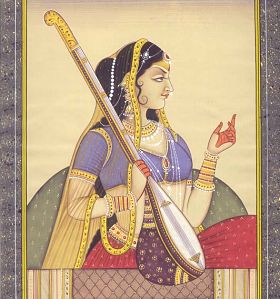42. In Good Taste: The Aesthetics of Rasa
Bharata’s Nāṭya-Śāstra and later works from Kashmir explore the idea of rasa, an emotional response to drama, music, and poetry.
Themes:
• M. Ghosh (trans.), Nāṭyaśāstra of Bharata (Varanasi: 1950-67).
• S. Pollack (trans.), A Rasa Reader: Classical Indian Aesthetics (New York: 2016).
• A. Amaladass, Philosophical Implications of Dhvani: Experience of Symbol Language in Indian Aesthetics (Vienna: 1984).
• A. Chakrabarti (ed.), The Bloomsbury Research Handbook of Indian Aesthetics and the Philosophy of Art (London: 2016).
• E. Gerow, Indian Poetics (Wiesbaden: 1977).
• K.M. Higgins, “An Alchemy of Emotions: Rasa and Aesthetic Breakthroughs,” Journal of Aesthetics and Art Criticism 65 (2007), 43-54.
• S.L. Schwarz, Rasa: Performing the Divine in India (New York: 2004).
Thanks to Malcolm Keating for advice on this episode!






Comments
Rasa
Thanks so much, Peter. I really enjoyed your talk on rasa. One statement I found particularly insightful - how even if the artistry is topnotch, the finest of the finest, the full rasa will only arise if an audience member is equally proficient, a connoisseur with the highest cultivation of taste. For my own experience of literature and the arts, this is the key. For example, I now have a greater taste of rasa reading The Tragic Muse by Henry James after dedicating many hours and much energy to reading a number of his other novels as well as many other authors of classical literature. Thus, I see the juice of rasa working on two levels: 1) appreciating the work of art in the moment and 3) being empowered to enjoy the work even more when returning for future exposure. Added to this, the rasa from one particular work empowers a dedicated connoisseur to squeeze even more juice from other works.
Seen in this way, even if there was a “pleasure machine” where the user could experience with intensity the eight emotional dispositions you note - 1) the erotic 2) the comic 3) the pathetic 4) the furious 5) the heroic 6) the terrible 7) the odious 8) the marvelous – such a machine would be inferior to works of art since it would, in all likelihood, not empower the user to experience rasa from other than the “pleasure machine.” Any reflections here?
In reply to Rasa by Glenn Russell
Rasa
Yes, that sounds plausible to me. I guess the question is whether your machine really helps shape the audience member's sensibility. Having said that, from what I read (which was far from what one could read about this, I only had time to scratch the surface) there was not a lot of discussion about how exactly the audience member comes to be so discerning, it's simply demanded that one be a connoisseur. Perhaps there is material on that I didn't see. But also now that I think about it, I don't think it is consistent with rasa theory that the machine just "produces" the emotions, because the production of emotions is a more complex process that involves the input of an author, the portrayal of the actors, the subsidiary emotions alongside the main theme emotion, etc. So really the aesthetic experience is produced by a range of factors and if any of them is missing, rasa will not result, and it's hard to see how a machine could replace all of that.
In reply to Rasa by Peter Adamson
Very well stated, Peter.
Very well stated, Peter. What I think this “pleasure machine” as thought experiment makes clear is the rasa of aesthetic experience is very rich indeed, one that requires not only an intensity of any one or combination of those eight prime emotions experienced by an observer but also expertise in presentation in the various elements of the various arts such as drama, poetry or music. Thus, in the end, the arts win out over machines, drugs or any other contrivance attempting to replace the arts.
Rasa in HOPWAG India 2
Here's my attempt at a HOPWAG-esque end-of-episode joke: Whose text is it? It's Bharata’s, Nāṭya-Śāstra
Add new comment